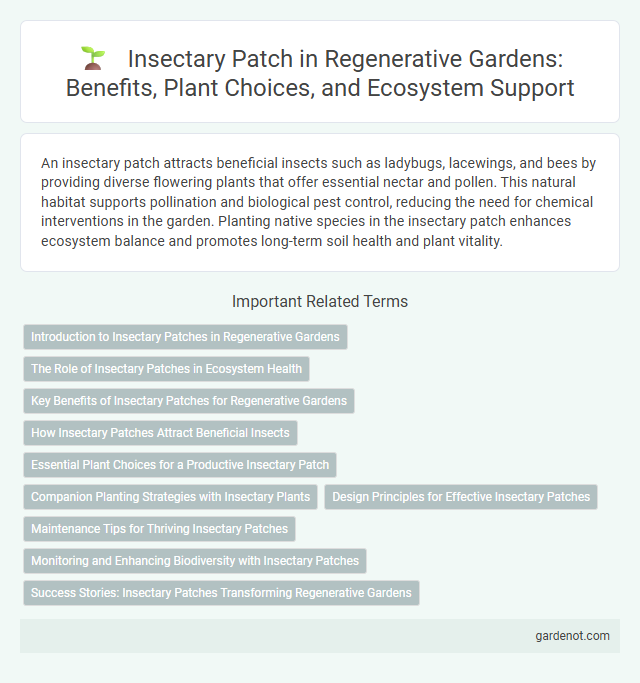An insectary patch attracts beneficial insects such as ladybugs, lacewings, and bees by providing diverse flowering plants that offer essential nectar and pollen. This natural habitat supports pollination and biological pest control, reducing the need for chemical interventions in the garden. Planting native species in the insectary patch enhances ecosystem balance and promotes long-term soil health and plant vitality.
Introduction to Insectary Patches in Regenerative Gardens
Insectary patches in regenerative gardens are specifically designed areas planted with diverse flowering plants that attract beneficial insects such as pollinators and natural predators of pests. These patches enhance biodiversity, improve pollination rates, and naturally control pest populations, supporting sustainable garden ecosystems. By integrating insectary plants like alyssum, dill, and marigold, gardeners foster a balanced environment that reduces reliance on chemical inputs.
The Role of Insectary Patches in Ecosystem Health
Insectary patches serve as crucial habitats that support beneficial insects such as pollinators and natural pest predators, enhancing biodiversity within regenerative gardens. These patches provide essential resources like nectar, pollen, and shelter, which help maintain balanced ecosystems and improve crop resilience against pests. Integrating insectary plants such as native flowering species fosters healthier soil, promotes natural pest control, and increases overall garden productivity.
Key Benefits of Insectary Patches for Regenerative Gardens
Insectary patches in regenerative gardens boost biodiversity by attracting beneficial insects like pollinators and natural predators, enhancing pest control without chemicals. These patches improve soil health through increased organic matter and promote ecosystem resilience by supporting a balanced food web. Incorporating diverse native plants ensures continuous blooms, providing habitat and nourishment for beneficial insects year-round.
How Insectary Patches Attract Beneficial Insects
Insectary patches attract beneficial insects by providing a diverse array of nectar-rich flowering plants that offer essential food resources throughout different growth stages. These patches create a habitat that supports pollinators such as bees and butterflies, along with natural predators like ladybugs and lacewings, enhancing pest control naturally. Strategic planting of insectary species like yarrow, dill, and coriander boosts biodiversity and sustains ecological balance within regenerative gardens.
Essential Plant Choices for a Productive Insectary Patch
Selecting essential plants such as native wildflowers, herbs like dill and cilantro, and nectar-rich species like alyssum ensures a productive insectary patch by attracting pollinators and beneficial predators. Incorporating diverse flowering plants with staggered bloom times supports continuous insect activity and enhances pest control. Prioritizing non-invasive, pesticide-free species maximizes ecological balance and fosters a thriving, regenerative garden ecosystem.
Companion Planting Strategies with Insectary Plants
Insectary patches utilize companion planting strategies by integrating insectary plants such as yarrow, fennel, and dill to attract beneficial insects like ladybugs and parasitic wasps, essential for natural pest control. These plants provide nectar and pollen, creating a habitat that supports pollinators and predatory insects, which improves overall garden health and biodiversity. Strategic placement of insectary plants near vegetable crops enhances pest suppression and promotes regenerative soil biology through increased insect activity.
Design Principles for Effective Insectary Patches
Effective insectary patch design prioritizes plant diversity to attract a wide range of beneficial insects, enhancing pollination and pest control. Incorporating native flowering plants with staggered bloom times ensures continuous nectar and pollen availability, supporting insect populations throughout the growing season. Proper spatial arrangement and habitat complexity promote insect refuge and improve ecological balance within regenerative gardens.
Maintenance Tips for Thriving Insectary Patches
Maintaining a thriving insectary patch requires regular monitoring to ensure a diversity of flowering plants that bloom throughout the growing season, providing continuous nectar and pollen for beneficial insects. Implementing organic mulching and avoiding chemical pesticides enhances soil health and protects delicate insect populations. Pruning spent flowers and managing invasive species promote plant vigor and sustain habitat quality for pollinators and predatory insects.
Monitoring and Enhancing Biodiversity with Insectary Patches
Insectary patches play a critical role in monitoring and enhancing biodiversity within regenerative gardens by attracting beneficial insects such as pollinators and natural predators. Implementing a variety of native flowering plants in these patches supports ecosystem balance and pest control while promoting soil health. Regular observation of insect activity helps gardeners adjust plant selection to maximize ecological benefits and sustain habitat diversity.
Success Stories: Insectary Patches Transforming Regenerative Gardens
Insectary patches foster biodiversity by attracting beneficial insects that enhance pollination and natural pest control, significantly boosting plant health and yield in regenerative gardens. Success stories reveal vibrant ecosystems where native pollinators and predatory insects thrive, reducing reliance on chemical pesticides and promoting soil vitality. Gardeners report increased productivity and ecological balance, showcasing insectary patches as essential components for sustainable agriculture.
Insectary patch Infographic

 gardenot.com
gardenot.com